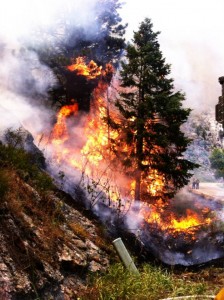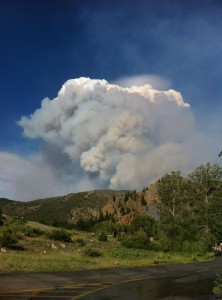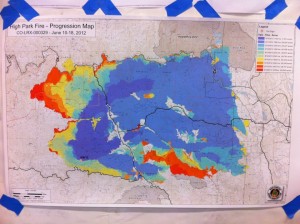Each GLOBE region has been affected at one time or another by wildfires. Last year, when we discussed the state of the climate for each region, there were mentions of wildfires specifically in the Africa region. The fires referenced then were the result of dry lightning – a phenomenon where thunderstorms are elevated so far above the ground that precipitation evaporates before reaching the surface. Cloud-to-ground lightning, however, continues to occur during these storms. But it’s not just lightning from dry thunderstorms that can ignite these fires; they can be started by many things that include human influences. Once they begin, weather conditions in the area are the biggest factor in mitigation.

A look at the High Park fire burning along a creek near Ft. Collins, Colorado in June 2012. Credit: Kerry Webster
Recently, the state of Colorado has seen a number of wildfires flare up. What causes these fires is always a point of concern. Was it a thunderstorm, a campfire that continued to smolder, the butt of a discarded cigarette from a passing vehicle or the spark of a chainsaw of a worker trying to remove a beetle kill tree to prevent a fire? Currently, there are eleven fires burning across the state, mostly in rural mountainous areas, but some have already destroyed homes and threatened more heavily populated areas, such as subdivisions on the outskirts of Ft. Collins, Colorado as well as in the city limits of Colorado Springs, Colorado.
In addition to threatening communities, these fires can create their own weather systems. Pyrocumulus clouds are often seen with very intense fires, such as firestorms, which are intense fire-driven wind systems. Firestorms are formed as the fire takes in air from all sides, forming an updraft. As the intake increases, the fire can grow even stronger as fresh air feeds it. Sometimes if the updraft is strong enough, it can form a pyrocumulus cloud. Sometimes these clouds can condense enough moisture that it falls as rain, helping to extinguish the fire. Other times, the cloud may grow so large that it becomes a cumulonimbus, producing additional lightning and sparking other fires.
The High Park Fire, occurring outside of the city of Ft. Collins, Colorado, is the second largest fire in state history. This specific fire was started by a thunderstorm that occurred in the early morning hours on 9 June 2012. As of publishing time today, the fire had consumed 87,284 acres. This fire, consuming many beetle kill timber, has continued to burn due to persistent hot and dry weather. Coupled with high winds, these three conditions make it easy for fire to spread and continue burning. Why do hot, dry and windy conditions fuel fires?
Hot weather, in general, increases evaporation rates. Evaporation is an essential part of the water cycle, driven by the sun. The sun heats the ground, which provides enough energy for water to transition from liquid state to vapor state. If hot weather persists long enough without relief, evaporation can exceed precipitation, which results in dry conditions. And if conditions stay dry for a long enough amount of time, plants die and become prime fuel for fires. Add in the beetle kill, and you have an area of land with timber and dry grasses just waiting to ignite. The final condition, high winds, is a fairly straight-forward condition: with high winds, sparks and embers are able to travel further than they would in calm conditions, allowing fires to grow quickly.

Close up of a tree on fire as part of the High Park Fire outside of Ft. Collins, CO in June 2012 Credit: Kerry Webster
The GLOBE program has protocols to examine many aspects of fires. In addition to atmosphere protocols that measure temperature and relative humidity, GLOBE has a fire fuel protocol that helps students measure the different types of fuels for fires. Students are able to learn about the different types of living and dead organic materials that can become fuels for wild fires. Through the use of this protocol, students can further understand fire behavior and effects, such as fire spread (how fast a fire moves) and fire intensity (the flame length).
As summer continues in the northern hemisphere, fire awareness becomes even more important. The State of Colorado has implemented a state wide fire burn ban; therefore no open flames are allowed until the ban is lifted. But Colorado isn’t the only place experiencing fires. Many states in the western United States are under fire watches, as the region experiences drastic precipitation deficits. The need for rain is high, and the summer, typically a relatively dry season for the region, is only beginning.
Special thanks to Kerry Webster, a firefighter with the National Park Service in Boulder, Colorado for providing the photographs in this post. Kerry has been actively fighting both the High Park Fire outside of Ft. Collins, Colorado as well as the Flagstaff Fire, which ignited on 26 June 2012 due to lightning in rural Boulder County, Colorado.
-Jessica Mackaro



I liked the article.
We have to be careful with wildfires, we must be cautious and take care our forests.
I agree with Vanesa-Dismon that we take care of our forests. Sadly there are ones out there will little respect for such things and enjoy destroying them.
I agree with Vanesa-Dismon that we take care of our forests. Sadly there are ones out there with little respect for such things and enjoy destroying them.
I liked the article.
We have to be careful with wildfires, we must be cautious and take care our forests.
It’s alwalys horrible to see forests burn. Hearing that so many fires occur because of cigarettes people throwing away makes me angry. What Colorado did is totally right, fires destroy so much of life and nature that it should be punished very hard to risk a forest fire.
Very nice read. I agree we have to take care of your wilderness, but years ago, we had as well wildfires which took care of themselfes. Now have have other things which start it, like uncontrolled fires, cigarettes or other things from humans.
A fascinating discussion is worth comment. There’s no doubt that that you ought to write more on this topic, it might not be a taboo matter but usually folks don’t talk about such topics.
To the next! All the best!!